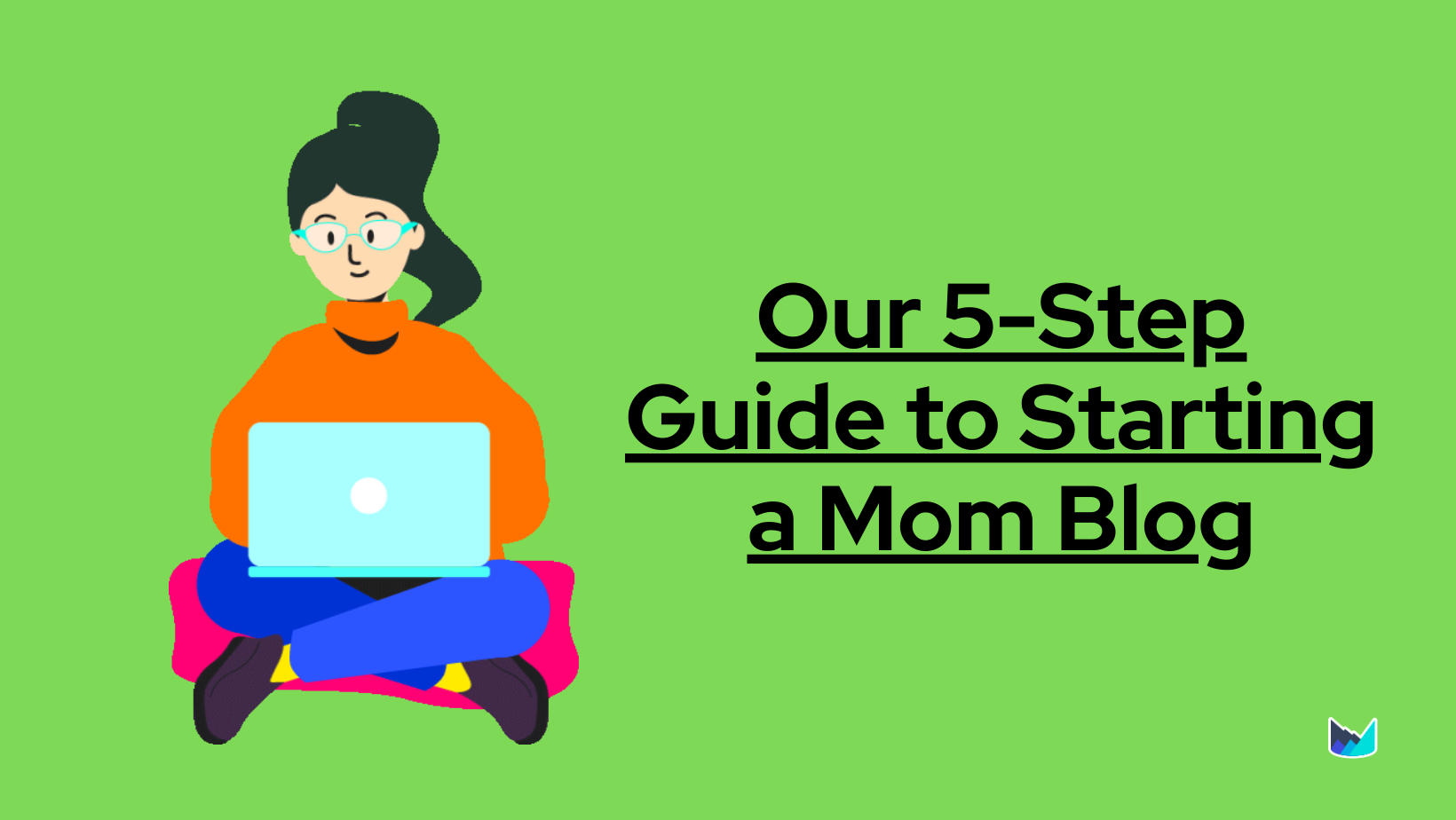- Product
- SEO Content Editor
- SEO Content Strategy
- Content Optimization
- Content Briefs
- AI Assisted Writing
- Keywords Clustering
Preview a demo walkthrough
Outranking the competition with our cutting-edge SEO strategies.
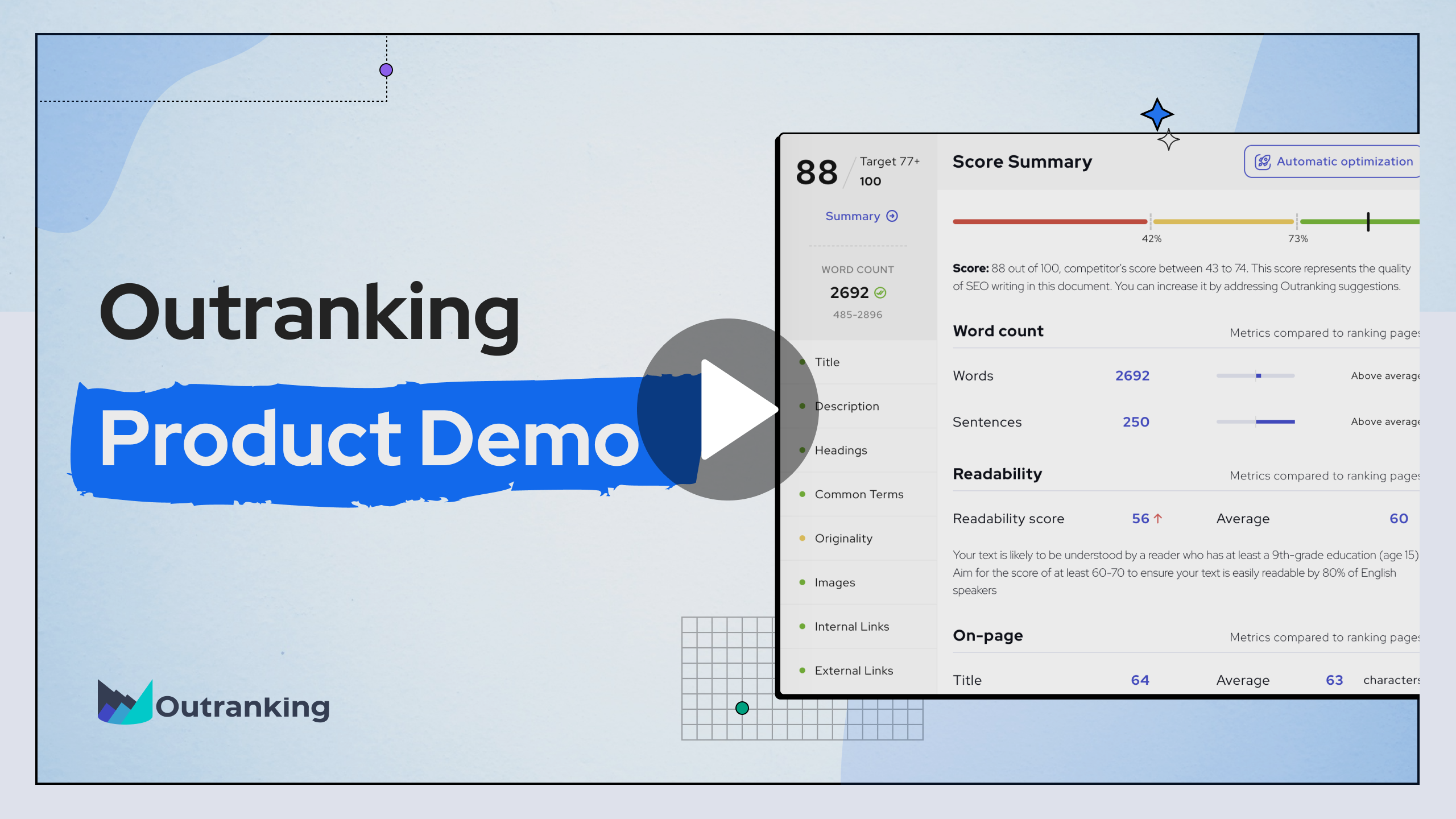
- Pricing
- Resources
- Sign In
- Get Started

Table of Contents
You don’t need to be a genius to dominate your industry with SEO content. Check if your site is SEO friendly using our SEO friendly URL test .
SEO is one of the most important aspects of online marketing. Understand the latest b2b SEO trends and how to utilize them for business growth. It can be the difference between being found by your target audience and remaining invisible. Implementing a comprehensive strategy doesn’t just boost your search engine rankings, it also helps you create engaging content that encourages your audience to take action. You’ll see an increase in traffic, leads, and sales from your website.
With so many moving pieces, it can be daunting to know where to start. This guide will help you develop a winning strategy for your website and call all the shots in your industry.
Table of Contents
What is an SEO Content Strategy?
An SEO content strategy is a plan for how you’ll create and optimize your website’s content to earn valuable traffic from search engines. This includes everything from the topics you write about and the keywords you target to how your pages are organized – the important details that ensure your content will bring ROI.
Just like any good recipe, a successful website starts with the right ingredients. In this case, those ingredients include ideas that impact business outcomes, a clear and concise website structure, and a content creation approach that everyone on your team can get behind. By ensuring that these critical components are in place from the beginning, you set yourself up for SEO success.
Why is Creating an SEO Content Strategy Important for Your Overall Content Marketing Strategy?
Let’s face it, creating content can be overwhelming. You might find yourself in a situation where you’re staring at a blank screen, unsure of what to write about. Perhaps you have too many ideas and don’t know where to start. That’s where having an SEO content strategy comes in handy.
Taking the time to plan your content can save you time and stress in the long run. Plus, there are some other benefits to having an SEO content strategy:
- You can prioritize tasks and see measurable results. This means you can allocate your time and resources more efficiently and improve your bottom line.
- It helps you stay focused. With so many different things vying for your attention, it’s easy to get sidetracked. With a plan, you can avoid distractions.
- You can increase your number of leads. By creating helpful, informative content, you’ll be able to attract more website visitors who are interested in what you’ve to offer. What’s more, they’ll be more likely to convert into customers or clients.
How to Create a Winning SEO Content Strategy
You’re going to find a crap ton of content on building an SEO content strategy that goes nowhere. This guide is going to be a little different than most as we focus on 10 necessary steps for building a winning SEO content strategy that works for all of your websites. We provide detailed examples of structuring your website, finding keywords, creating amazing content and setting up processes that work every time:
Step 1: Create website architecture and define areas to build authority
Step 2: Make a list of keywords that align with your objectives
Step 3: Cluster keywords to determine your focused topics
Step 4: Select a primary keyword for each cluster group based on ranking potential
Step 5: Create a content calendar for continuous content creation
Step 6: Establish content production process, SOPs, and content briefs
Step 7: Track content using Google Search Console
Step 8: Optimize internal linking
Step 9: Find new opportunities to build topical authority
Step 10: Identify underperforming pages
I broke these steps down into individual sections so we can get to the bottom of each process for repeatable success. If you would rather watch a video to understand how to build SEO content strategy, check out the youtube video below, or else continue with the guide.
Step 1: Create Website Architecture and Define Areas to Build Authority
What are you really trying to sell? Are you trying to sell advertising space on your website, or are you looking to promote a specific product or service? Before diving into keyword research, decide what areas connect most with your core offering.
Let’s take two examples.
Example 1: Outranking Website Architecture
What do we do?
Outranking is an SEO content audit tool, offering comprehensive on-page optimization, and content strategy solutions.
Core offering areas:
- SEO Content Strategy
- SEO Content Writing
- SEO Content Optimization
- SEO Content Planning
| Core Offering Areas | Extended List of Sub Areas |
| 1. SEO Content Strategy | 1. Topical authority 2. SEO content strategy 3. Topic clustering 4. Keyword clustering 5. Keyword strategy |
| 2. SEO Content Writing | 1. SEO content 2. AI writing 3. SEO writing 4. Blogging 5. Blog writing |
| 3. SEO Content Optimization | 1. SEO Content Optimization Tool 2. On-page SEO 3. Content audit tools 4. Content analysis |
| 4. SEO Content Planning | 1. Editorial calendar 2. Content briefs 3. SEO content workflow |
Example 2: Godfreypontoonboats.com Website Architecture
What do they do?
Godfreypontoonboats is a fishing, recreational, and inflatable pontoon boat manufacturer.
Core offering areas:
- Fishing Pontoon Boats
- Inflatable Pontoon Boats
- Recreational Pontoon Boats
| Core Offering Areas | Extended List of Sub Areas |
| 1. Fishing Pontoon Boats | 1. Fishing pontoon boats |
| 2. Inflatable Pontoon Boats | 1. Portable pontoon 2. Inflatable pontoon 3. Lightweight pontoon 4. Small pontoon |
| 3. Recreational Pontoon Boats | 1. Family pontoon 2. Luxury pontoon 3. Deep water pontoon 4. Large pontoon 5. (X) person pontoon |
The goal of this step is to identify the key areas where we’ll be conducting keyword research and developing a plan. Here, we’re not trying to tackle every possible keyword. We’re just structuring our website in a simple format before building it out.
Note ☝️ Not all websites will structure their menu and footer in this way, but for our purposes, we’ll be using this approach.
Set Up Google Search Console and the Website Project
Whether your website is new or has been around for a bit, you’ll need a Google Search Console (GSC). It will be a critical tool for scaling your SEO content strategy, even if you don’t have any keyword ranking.
Simply create a new Domain project in Outranking and connect your Google Search Console or use one of the existing methods to gather your domain ranking information. Since we don’t have access to Godfreypontoonboats.com’s GSC, we’ll use an alternative method to collect domain ranking insights.
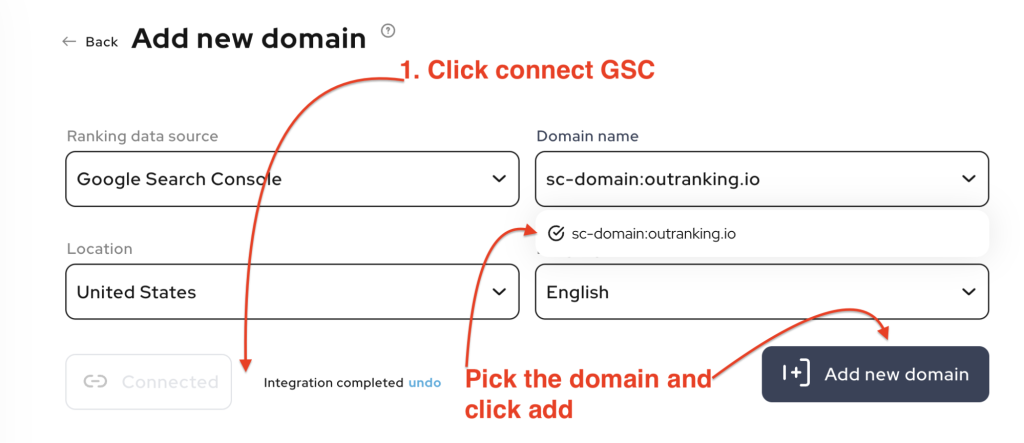
Why do we do this first? So that when we build out the content plan, we know what we’ve already done and what we need to do. By mapping the ranking data to your keyword analysis, we’ll have a clearer picture of what needs to be prioritized.
Once finished, your dashboard will load and you’re ready to go to the next step.
Step 2: Make a List of Keywords That Align With Your Objectives
This step is all about gathering the keywords we want to analyze before building our strategy.
Things to keep in mind:
- The goal here is to gather the list of keywords in each of the core areas of your website.
- If you’ve multiple core areas, you’ll need to repeat this step.
- If each core offering area has multiple sub-areas of focus, you’ll need to perform this step again for each sub-area.
To explain this step, we’ll use the Suntrackerboats example from their first core offering “Fishing pontoon boats”.
Method 1: Use Your Favorite Keyword Research Tool
Plug in Fishing pontoon boat as a keyword in the keyword research tool. ( here we use Semrush )
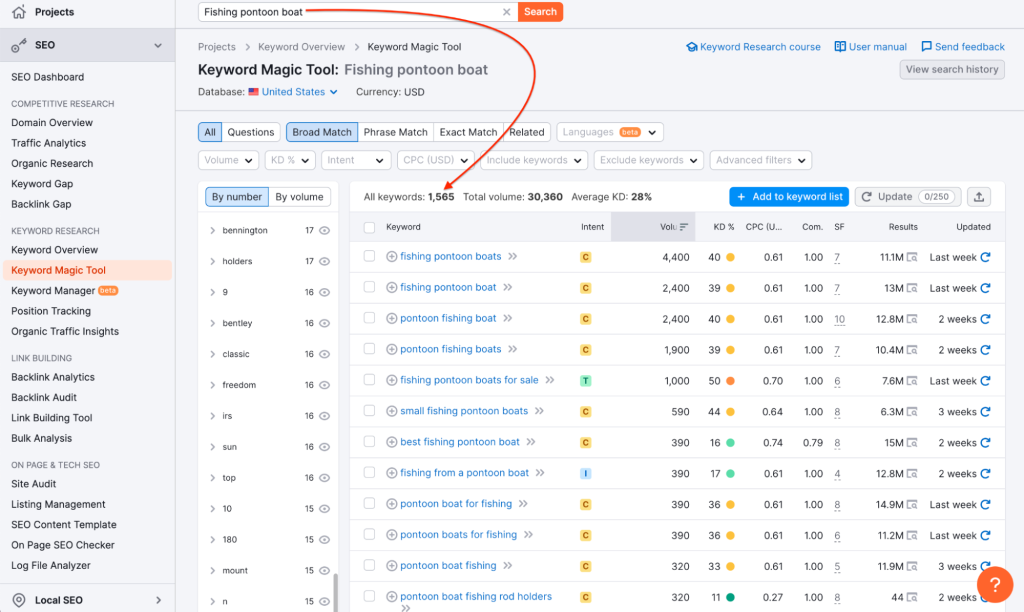
Exclude keywords with outdated or clearly irrelevant phrases. Analyzing extra keywords costs time and money. Take time to toss excess certain keywords so you can focus on analyzing the most important ones more efficiently.
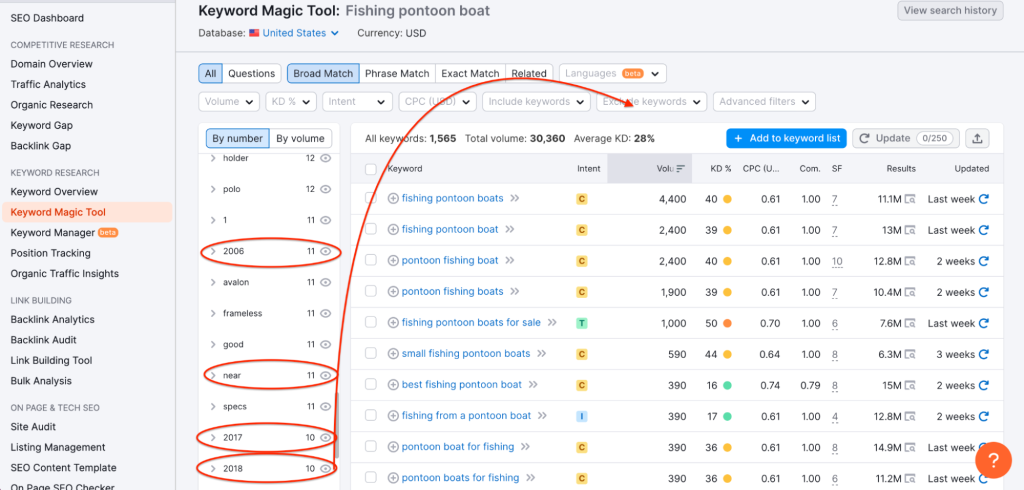
Download the CSV file. We’ll need this file to analyze every keyword in the file to build a content strategy.
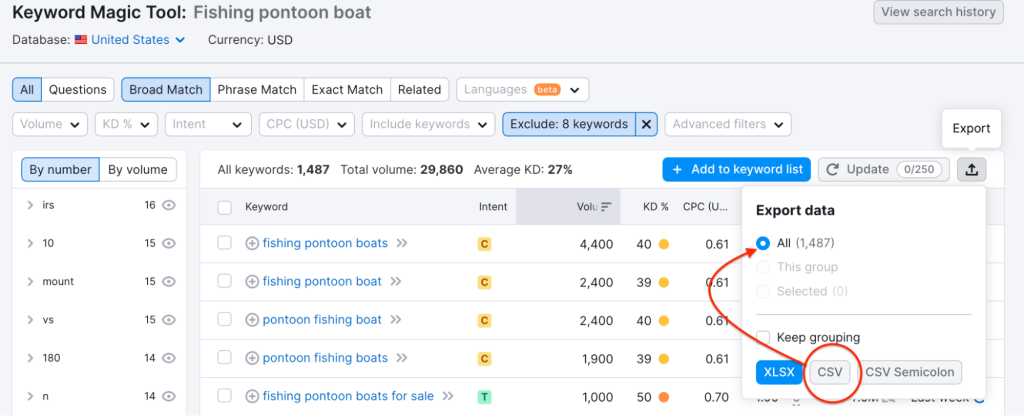
files for easier management.
Method 2: Use Outranking to Gather Keywords
You can use Outranking to gather your keywords as well. Outranking won’t give you the list of keywords like other tools would. Instead, it’ll automatically take you to the next step –keyword refinement.
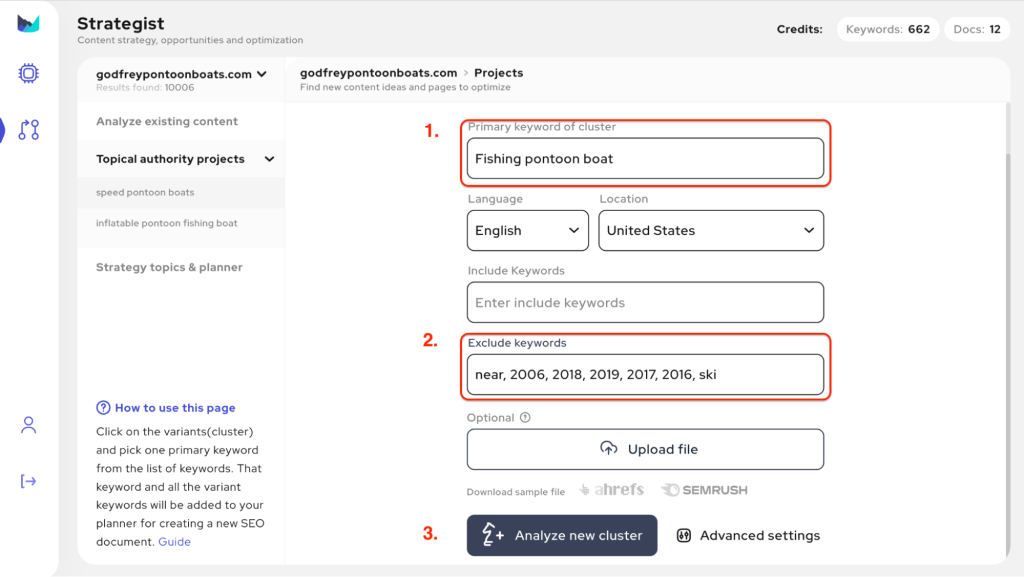
While Outranking isn’t a keyword research tool, it can gather keywords and analyze them. The choice is totally up to you – use the keyword research tool that you’re most comfortable with and give you the data you need.
Alright, now we’re ready to go to the next step, which is refining your keywords.
Step 3: Cluster Keywords to Determine Your Focused Topics
While you’re free to use any clustering tools, we’re going to look at Outranking’s clustering tool to analyze these keywords and group them into semantic terms and similar intent groups.
You can read the Complete Guide on Keyword Clustering and more about the tools on our other blog.
We’ll now upload the keyword list we have into a new clustering project. We’ll call the project “Fishing Pontoon Boat”. For this example, I narrowed down the list to 289 keywords.
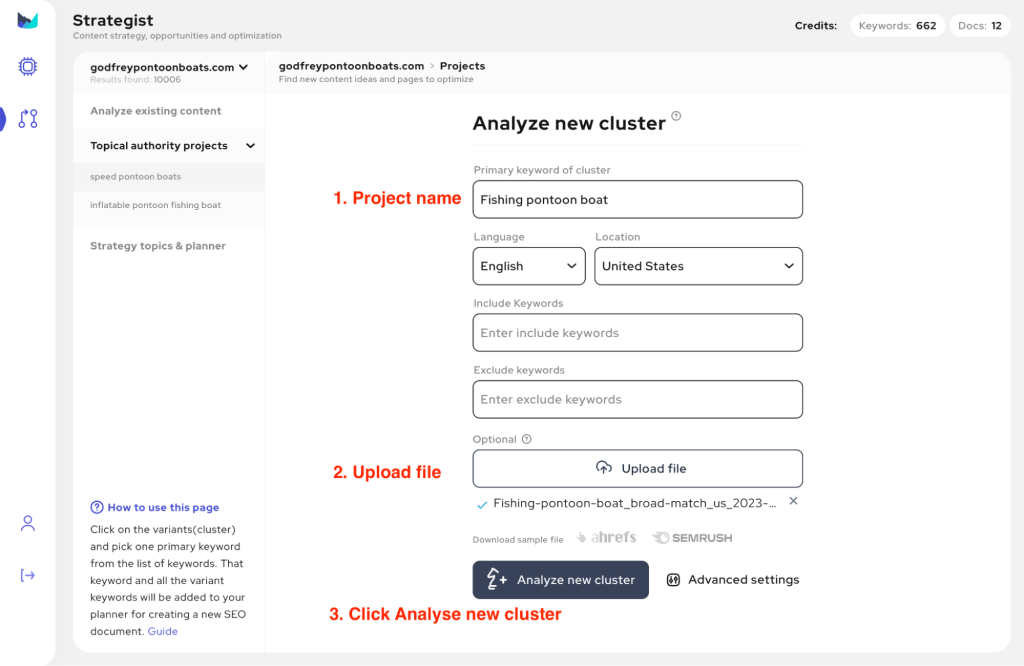
If you’re using Outranking to gather the research, you can follow the same steps but without uploading any files.
Click Analyze new cluster
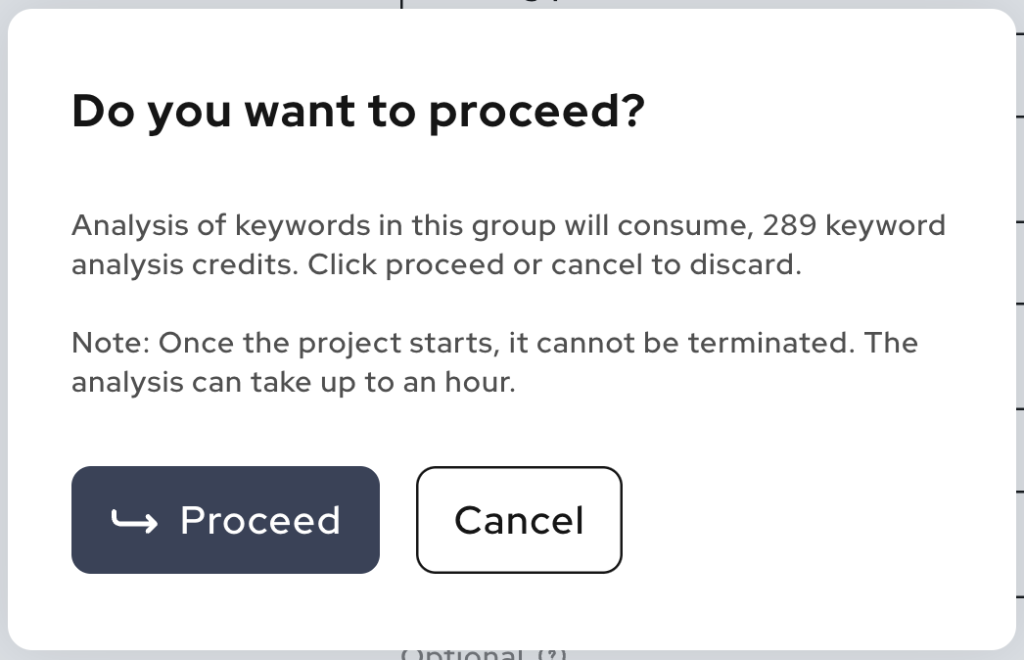
Analyzing all these keywords can take a few hours if you have a lot of keywords. So hold your horses or go lift some weights in the gym – by the time you come back, you’ll have your refined keyword list waiting for you
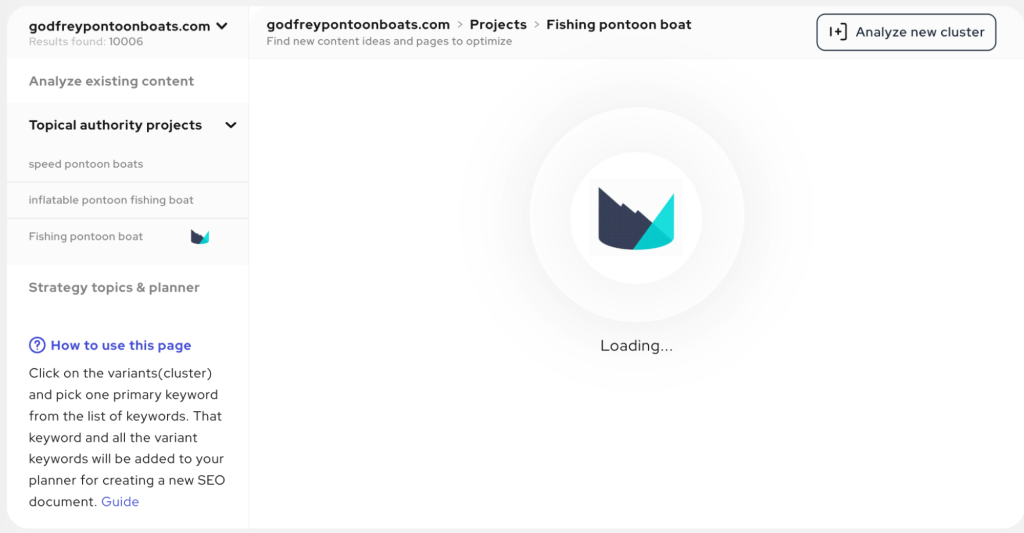
Once the analysis is complete, it’ll show you the list of keywords with all the assessed data and variants next to each keyword.
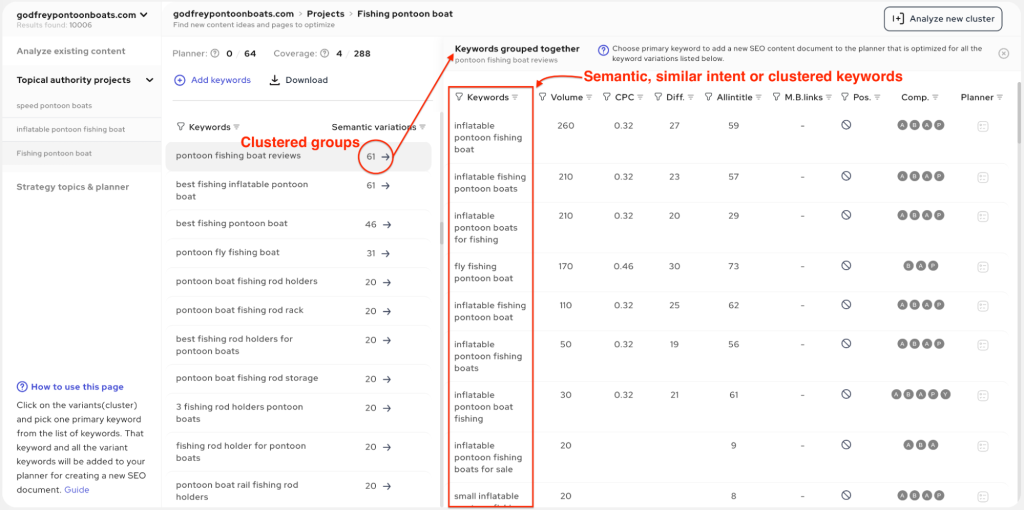
The “Similar Variations” (clustered keywords in one group) are other keywords that are semantically related or serve the same intent.
Click Similar Variations and pick a primary keyword to use in the next step.
Step 4: Select a Primary Keyword for Each Cluster Group Based on Ranking Ability
This is where most people, including myself, make mistakes – a mistake I made a dozen times before finally getting it right. To rank well in search engines, take your time here 🧐.
Once all the keywords have been processed and analyzed, Outranking will group them into distinct groups.
Our goal in this step is to identify ONE primary keyword in each group.
Click Semantic Variations in the last column to see the keywords in this cluster group.
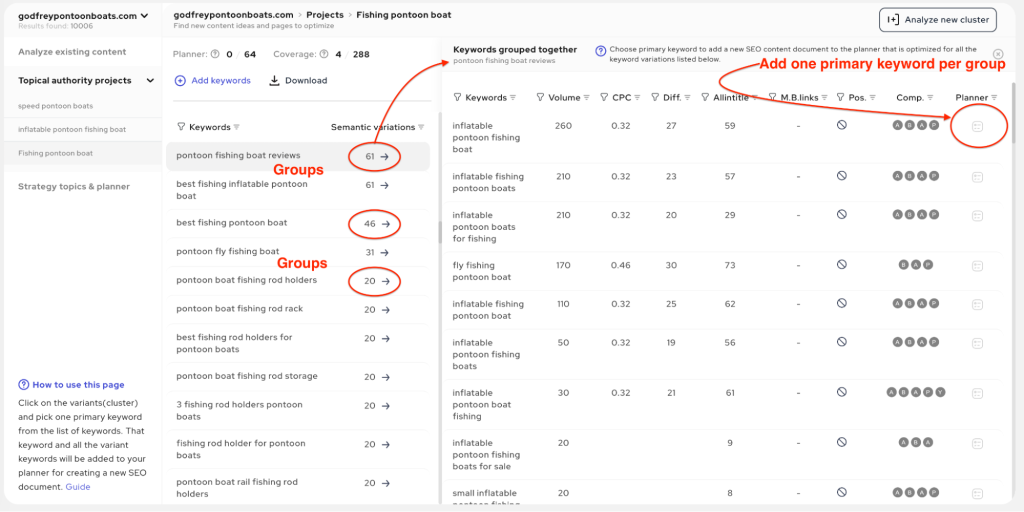
How to Pick a Primary Keyword for Each Group for Your SEO Content Strategy
Your ability to rank for a keyword depends on several factors:
- Can you create better content than competing web pages?
- How many backlinks do your competitors have?
- Is there a knowledge gap or underserved area in the intent?
- What is your topical authority, and who are your common SERP competitors?
While we brainstorm, we’ll label keywords based on their difficulty for success. Next, I’ll show you some quick concepts to remember before labeling keywords.
How to Check Who The Top Competitors for This Group of Keywords Are
Often, your direct competitors aren’t your search competitors. Gauging what the competition looks like for your topical authority project can be incredibly insightful.
The two questions you want to ask are:
- Who is the dominant competitor for these relevant keywords?
- Can you outperform at least 2 of the top competitors?
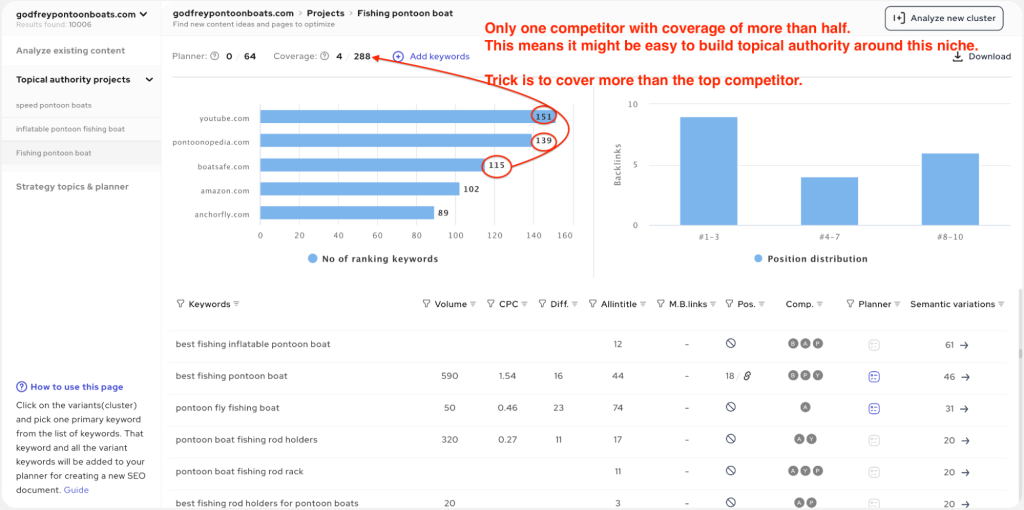
How to Measure Your and Your Competitor’s Topical Authority
What does the keyword coverage look like for those competitors? If you find multiple competitors covering a great deal of your project, chances are it’s going to be difficult to stand out. Even if you rank in the top 5 positions, reaching the top 3 can be nearly impossible.
But this isn’t going to stop me from going after some keywords 🦾. I’m going to study the competition so I can pick keywords that avoid these guys wherever possible. See the image above with the red circles for reference.
How to Check The Competition’s Minimum Backlinks and Understand Its Importance
We want to see if we actually have a shot at ranking for a given keyword with little to no backlinks. Get the overall idea of how many backlinks at minimum are recorded for the ranking pages, with 0-10 being gold mines.
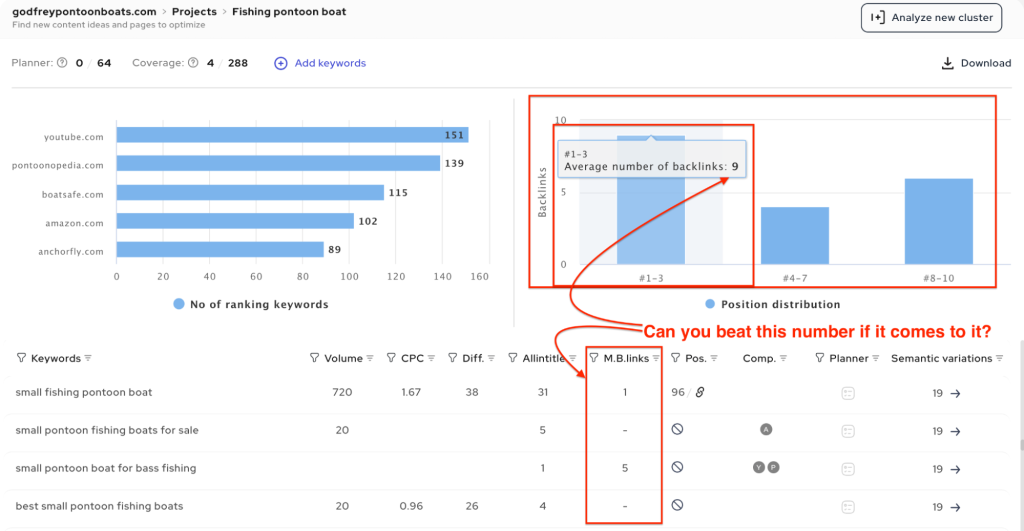
| Hard | • Any keyword that has all 5 of the most appearing competitors ranking • Any keyword that has more than 50 backlinks minimum from the top 7 ranking pages (no one looks below that) • Allintitle: total searches of more than 1,000 I don’t rely on search volume data as the sole factor for measuring content success. |
| Medium | • Any keyword that has all 3-4 of the most appearing competitors ranking • Any keyword that has less than 10-50 backlinks as a minimum from the top 7 ranking pages. • Allintitle: total searches that are no more than 1,000 (Pro tip: don’t overthink this – 1,001 is basically 1,000) I don’t use competition data as the only indicator for content success. It’s largely influenced by backlinks, so focus on actual backlink numbers instead of a derived metric. |
| Easy | • Any keyword that has no more than 3 of the most appearing competitor’s ranking • Any keyword that has less than 10 backlinks as a minimum from the top 7 ranking pages. • Allintitle: total searches under 200 |
How Do You Choose Which Category of Keywords to Go After?
Go after Easy if you’re a relatively newer website with a limited budget to acquire backlinks and put five people on the payroll to manage this.
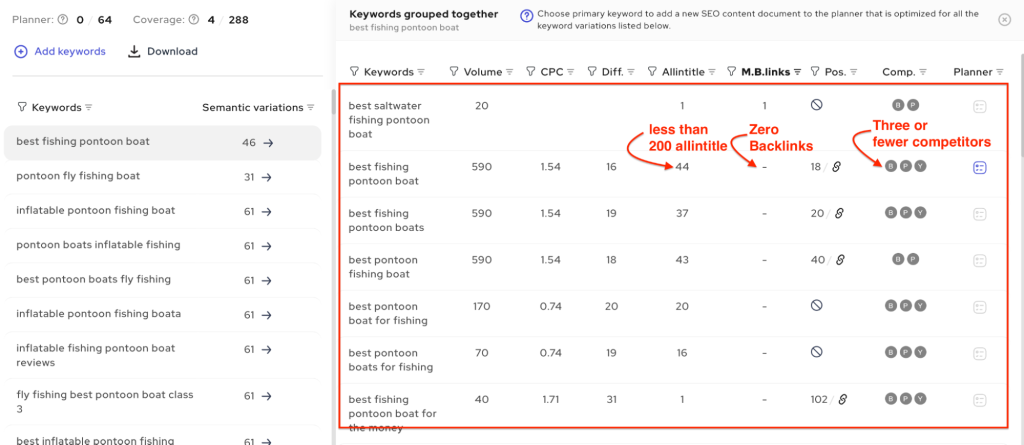
Go after Medium if you’ve started to build some topical authority in this area. In our example above, I’ve already written some content about boating that’s ranking. Ranking for a keyword once you have some authority in the niche becomes increasingly easier.

Go for Hard if you have tons of authority, your website is established, and have the budget to acquire backlinks. I usually go after these groups if the keyword is a commercial intent keyword that can bring qualified leads.

For each group, I would select the keyword that’s easiest to rank for and can bring qualified traffic to my website. “Qualified” is the key!
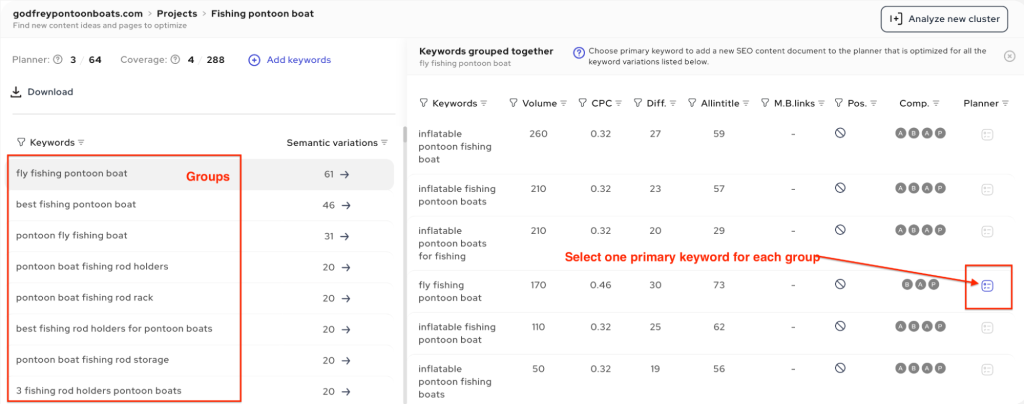
Repeat the process of selecting the primary keyword for each cluster group that’s relevant from the entire list of keyword analyses. Remember – don’t base your decision just on search volume; think about your business objectives.
Once you’ve selected the primary keyword for each group, the number of keywords in the main list will reduce. You’ll see an “in planner” icon next to the topic groups you’ve chosen a keyword for. Picking primary keywords takes time, but it’s important to do it right to avoid any headaches down the road.
Step 5: Create a Content Calendar for Continuous Content Creation
Once you’ve your list of primary keywords and groups, the rest gets a little easier. Since in the earlier steps we opened up each group and picked the primary keyword, all those topics have been added to our content planner.
Click Planner to see the entire list of topics you’ll be using to create your content calendar.
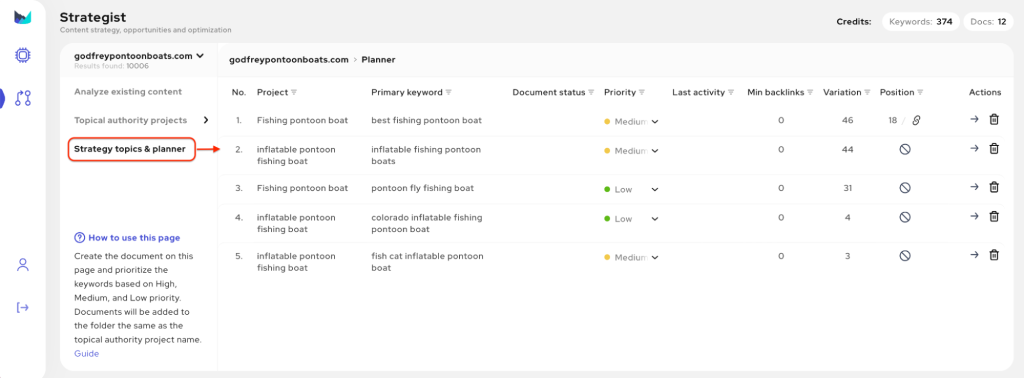
But having a list isn’t enough. You’ll need to prioritize it.

There are three priorities we’ll set – High, Medium, and Low:
| Priority | Keywords Containing | Why |
| High | Alternatives, Comparison | Can define you as a thought leader and support your important pages for the flow of information |
| Medium | Best, Top | Can place your product or service among many competitors |
| Low | How-to and Educational Guides | Can define you as thought leader and support your important pages for flow of information |
Once you’ve set the priority for the whole list of keywords in this clustering project, congratulations! You’ve made it further than most content strategists 🎉.
With a complete list of keywords you can execute, planning a year’s worth of content should be a walk in the park.
Step 6: Establish a Content Production Process, SOPs, and Content Briefs
All this planning won’t work if you don’t have a process in place. It is super easy to be distracted with thousands of keywords and ideas floating around. The point is to stick to a plan!
Once you’ve gathered all your documents in your planner, it’s time to move them to your favorite task management system. Outranking has predefined workflow status that you can customize to quickly fit your needs.
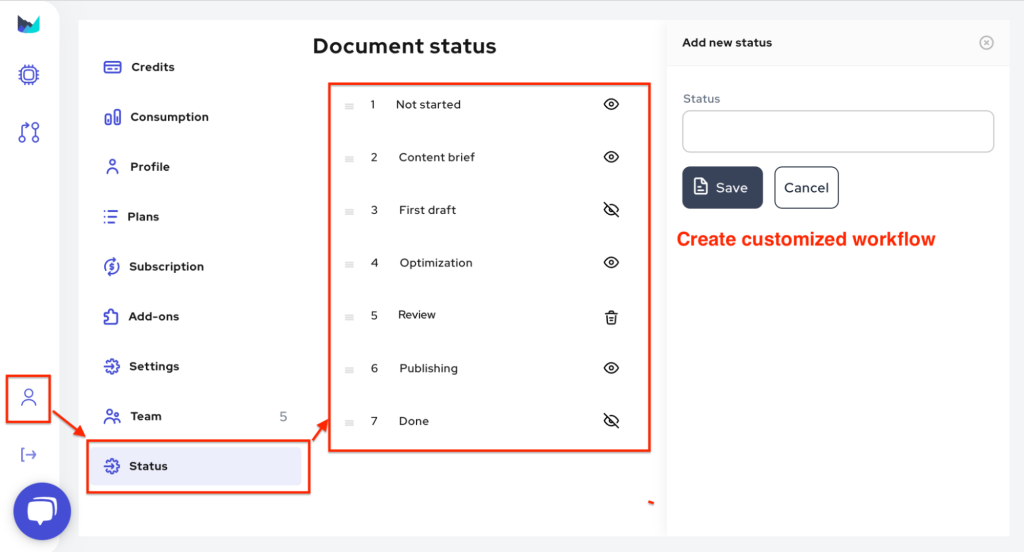
Next, you can create content using Outranking’s Kanban view.
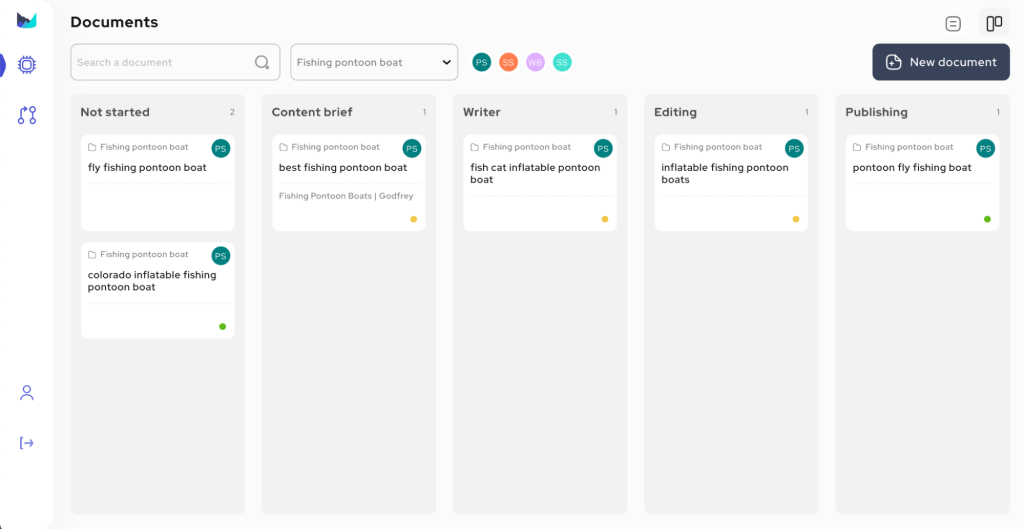
By doing so, you’ll have a complete content plan for the next six months.
To create your content, you can use Outranking’s integrated tool to either build content briefs or create content directly in your SEO content strategy.
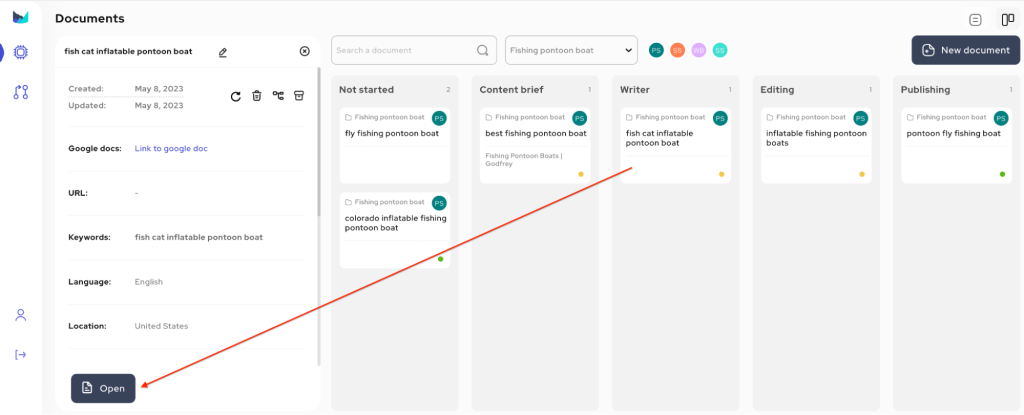
With a well-defined content production process, you can stay organized and focused, ensuring your strategy is executed successfully.
Step 7: Track Content Using Google Search Console
You can skip this step if your website is new as you likely will have no ranking data. However, if your website has been around for a while, using Google Search Console can be a surefire way to drum up more organic traffic.
Having a content plan for the next few months gives you some extra time to optimize your existing content or find new opportunities based on your ranking data. This step can accelerate traffic in three different ways as it:
- Uses data to find pages that need better internal linking structure to improve Pagerank.
- Uncovers new areas and ideas to create fresh content that can easily rank.
- Exposes underperforming pages and either improves them or redirects them, especially for medium to large websites with many pages.
See my post about how to optimize your existing content without updating the content here.
Since we connected to the Google Search Console in the second step, you can take the following actions depending on your goals:
| Optimize internal linking | Find pages with keywords in the top 4-14 positions |
| Find new opportunities to build topical authority | Pages with no ranking keywords in the top 20 positions that don’t align with the user’s search intent |
| Find underperforming pages | Pages with no ranking keywords in the top 20 positions that don’t align with user’s search intent |
Examine each scenario and determine what steps you can take to best improve your SEO content strategy.
Step 8: Optimize Internal Linking
Agenda: Find pages with keywords in the top 4-14 positions
Check out the image below to find the pages on your website you rank in the top 4-14 positions. The more light and dark green you see, the more chances you’ve of increasing traffic from those pages. These are the pages ranking between 1 and 10.
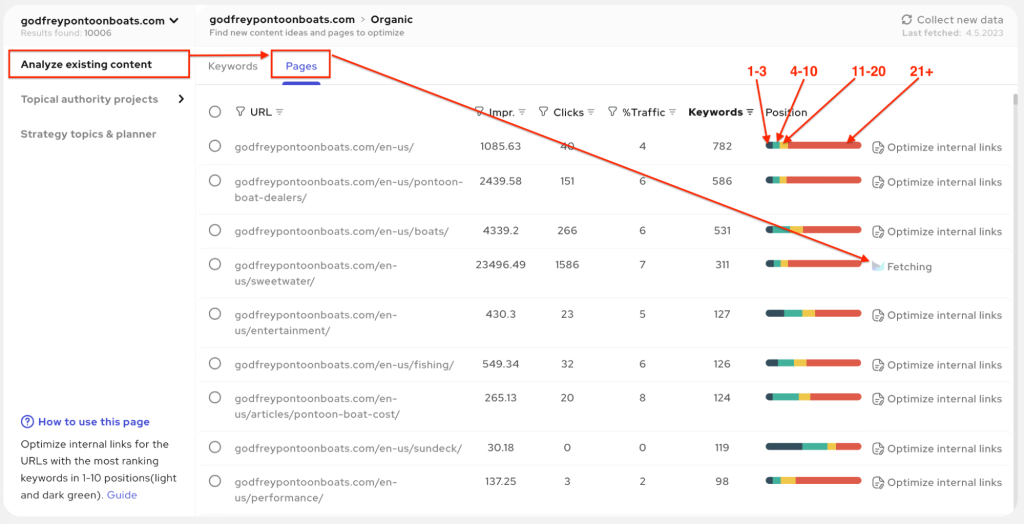
The trick is to get more internal links from pages that are already ranking and have some authority. You want to borrow the authority of those pages and transfer some over to the page you want to rank for more keywords.
Click on the internal linking icon next to URLs with a lot of light and dark green.

After a few seconds, suggestions for internal linking will load.
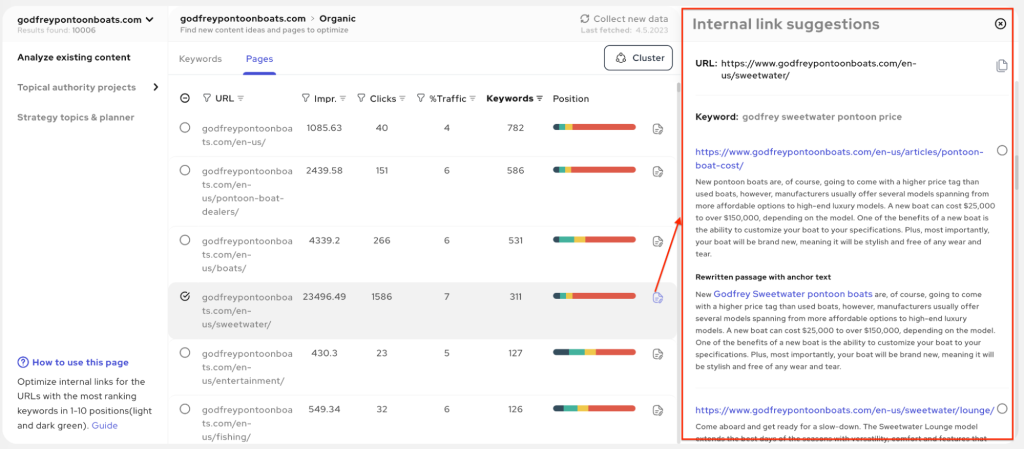
Now pick the URL you want to get a link from and select Rewrite with an internal link. The AI will rewrite the passage with the anchor text added to the keyword. Copy this passage and replace it with the original on the page.
Try getting as many links as you can from the given suggestion. This tactic almost always works and can improve your website’s ranking.
Step 9: Find New Opportunities to Build Topical Authority
Agenda: Cluster-related keywords or pages relevant keywords in the top 14 positions.
To build topical authority, cover distinct yet interrelated topics by identifying common words or phrases in your topics and covering more ground around those phrases.
Google Search Console data will display any keywords you distantly rank for. If your page already ranks for certain keywords, Google Search Console data will show what keywords you rank for in distance. This is an indication that you already have some authority in those areas and Google is ranking you even though your content doesn’t center around that specific topic.
So what will happen if you do have good content that targets those keywords? They’ll almost instantly rank. To group similar keywords and build topical authority, we filter our domain data by a common term and then filter our keyword data.
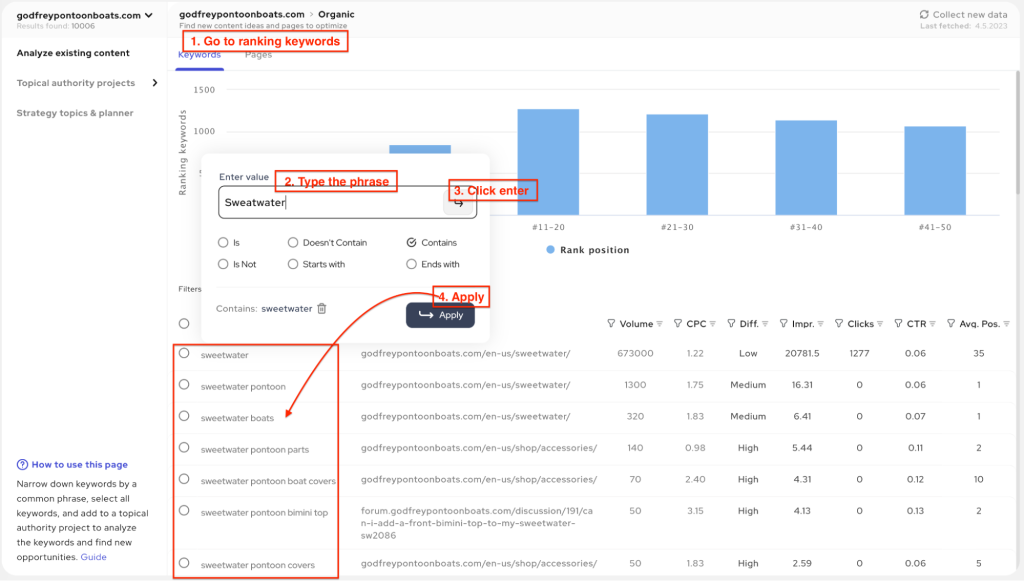
Next, select all the keywords and add them to a new cluster to identify distinct ideas. We don’t want to be writing about topics that are too similar.
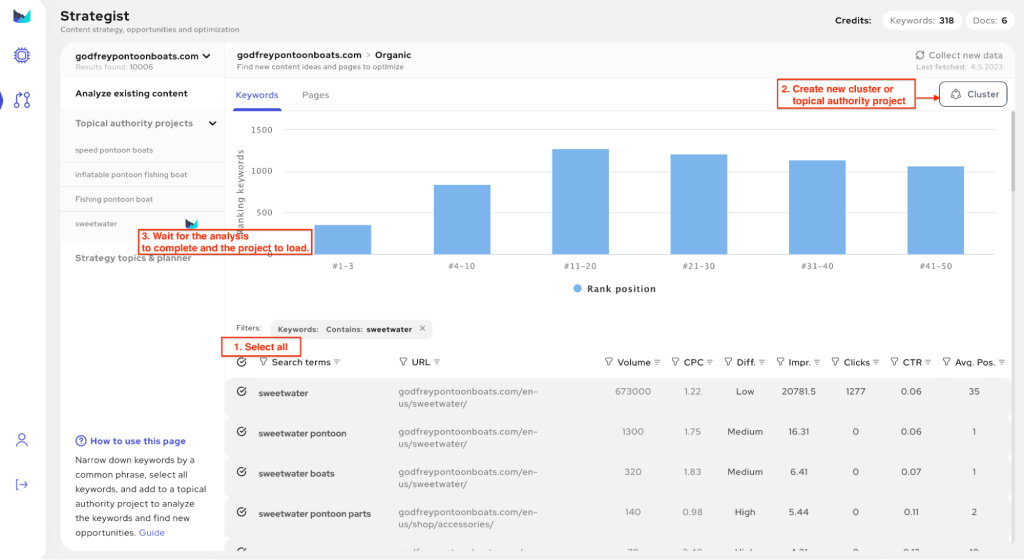
Now you can go back to the previous step where we clustered the keywords and decide what content to create. You may also find pages you already rank for in this cluster, so you can perform a complete audit on them and republish them using the planner.

Step 10: Identify Underperforming Pages
Agenda: Pages with no ranking keywords in the top 20 positions that don’t align with user’s search intent
Identifying underperforming pages on your website is important for improving your organic traffic. To find these pages, you can use the “page data” found in Google Search Console. Look for pages that have no ranking keywords under 20 – these are likely to be off-intent pages. The pages with NO greens are the ones we’ll be looking at.

Pages with yellow need content optimization, while pages with red aren’t aligned with user intent and aren’t generating any traffic. Depending on the importance of the page, you can choose to either reoptimize and publish the content, or delete it and redirect to a more relevant page on your site. Use this information to make informed decisions about your website’s content strategy.
8 Tips to Ensure a Successful SEO Content Strategy
1. Set Up the Right KPIs – Don’t Get Stuck on Keyword Volume and Competition Numbers
It’s important to choose the right metrics to measure the success of your SEO content strategy, rather than getting stuck on just keywords volume and competition numbers. While these factors should be considered, relying solely on them can be limiting. It is essential to focus on other metrics that can provide a more comprehensive understanding of your SEO performance.
Here are some examples of relevant KPIs to consider:
Organic Traffic | Measures the number of visitors that come to your website through organic search. Understand how well your content is performing in search engines (if you do ads). |
| Click-Through Rate (CTR) | Measures the percentage of users who click on your website link after seeing it in search results. A high CTR indicates that your content is relevant and engaging. |
| Bounce Rate | Measures the percentage of users who leave your website after viewing only one page. A high bounce rate may indicate that your content isn’t meeting user expectations. |
| Conversion Rate | Measures the percentage of users who take a desired action on your website like filling out a form or making a purchase. Understand how well your content is converting visitors into customers. |
To measure these KPIs effectively, you can use tools like Google Analytics. Set up specific goals and track your progress regularly to identify areas for improvement. For example, to measure organic traffic, you can use the “Acquisition” section in Google Analytics to see the number of visitors from organic searches.
To measure CTR, you can use Google Search Console to see the average position of your website in search results and the number of clicks it receives. To measure conversion rate, you can set up conversion tracking in Google Analytics and track the number of completed goals.
While keyword volume and competition numbers are important, focusing on other relevant KPIs can provide a more comprehensive picture of your SEO performance. By measuring and analyzing these KPIs regularly, you can make informed decisions about your SEO strategy and optimize your content accordingly.
2. Don’t Confuse Real Competition with SERP Competition
It is important to understand the difference between your real competition and your SERP competition when creating an SEO content strategy. Real competition refers to businesses that offer similar products or services as you, while SERP competition refers to the websites that appear on the same search engine results page as you.
Though it is important to track your SERP competition to improve your click-through rate and attract more customers, it is equally important to focus on your real competition to differentiate your brand and offer unique value to your customers.
By knowing your real competition, you can create a targeted SEO content strategy that speaks directly to your audience and sets you apart from the competition.
3. Leverage AI for SEO, but Not with a Blind Eye
To effectively leverage AI for SEO in your content strategy while still maintaining a human touch, it is important to strike a balance between using AI and incorporating human creativity and a data-driven approach in crafting engaging content.
You can use AI to create content faster with tools like ChatGPT and tools like Outranking that use ChatGPT for SEO. However, it is important to be cautious about the kind of content you publish. While AI can help you create content faster, ultimately it’s your users who will decide if your content is valuable and worth their time.
In the end, ensure that your content is high-quality, relevant, and provides value to your audience.
4. Perfect On-page Optimization SOPs to Ensure Quality Content Every Time
On-page optimization is a critical component of any SEO content strategy. This involves optimizing individual web pages through content, HTML source code, and images in order to rank higher and earn more relevant traffic from search engines. To ensure consistent and quality output, it’s important to have a well-defined SOP for on-page optimization.
Check out how you can do that at each step of production:
- Content Briefs: Create a brief that outlines the purpose of the page, target audience, keywords, and other relevant information.
- First Drafts: Once the content brief is ready, create the first draft of the page content. Ensure that the content is well-written, engaging, and optimized for the target keywords.
- Optimization: After the first draft is ready, optimize the content for on-page SEO factors like title tags, meta descriptions, header tags, internal linking, and keyword density.
- Editing: Edit the content for grammar, spelling, and readability. Ensure that the content is error-free and easy to read.
- Review: After editing, review the content to ensure that it meets the content brief’s objectives and is optimized for the target keywords.
- Publishing: Publish the optimized content on the website.
SOPs guarantee that the same quality output is delivered every time. It is crucial to document every step of the on-page optimization process to create a repeatable process regardless of who follows it. It also saves time and reduces errors by removing the guesswork required to complete the task.
Tools like Outranking can streamline the entire SEO content strategy, including on-page optimization. Outranking is an all-in-one SEO platform that provides keyword research, content optimization, and performance tracking. It offers keyword suggestions, content optimization recommendations, and performance metrics to help you optimize your pages efficiently.
5. Focus on EEAT and Content Quality
In SEO, the importance of Experience, Expertise, Authoritativeness, and Trustworthiness (EEAT) cannot be overstated. Google’s focus on rewarding quality content has made it pertinent for websites to prioritize these factors in their content strategy.
To ensure EEAT is incorporated in your content, conduct thorough research on your topic to establish your expertise and authority on the subject matter. Additionally, make sure that your content is well-structured and easy to navigate, providing a positive user experience.
Cite credible sources and consider adding affiliate links to reputable websites to establish trustworthiness. Finally, engage with your audience through social media and other channels to build a community and establish your website as a reliable source of information.
By prioritizing EEAT and quality content, you can improve your website’s search engine ranking and attract more traffic.
6. Get Your Team on the Same Page
Clear communication and collaboration between team members are essential for achieving goals and producing high-quality content. To establish team alignment, set clear goals and assign specific responsibilities to each team member. This will ensure that everyone is aware of their role in the project and can work together towards a common objective.
Regular check-ins and progress updates are also important to keep everyone on track to meet project milestones as planned. This can be achieved through regular meetings or through the use of project management tools such as Trello or Asana.
Accountability is crucial too. Each team member should be held responsible for their assigned tasks, meeting deadlines, and producing high-quality work. Regular performance reviews and feedback sessions can help achieve this.
Good team alignment increases efficiency, produces better-quality content, and creates a more cohesive team. By working together towards a common goal, team members can leverage each other’s strengths and produce work that’s greater than the sum of its parts. In conclusion, team alignment is essential for a successful SEO content strategy and should be a top priority for any team looking to achieve its online goals.
7. Plan for Acquiring Links to Best Utilize Off-page SEO and Backlinks
Off-page SEO and backlinks are crucial components of any successful SEO content strategy. Though backlinks are one of the most important ranking factors, not all backlinks are created equal – low-quality links can harm your website’s rankings.
Focus on building a high-quality link profile by using backlink analysis tools like Majestic, Ahrefs, Moz’s Links Explorer, or Serpstat’s Backlink Analysis tool. These tools can help you identify the quality of the links pointing to your website and also find new opportunities to build more high-quality links.
Additionally, create credible content that journalists and other websites naturally want to link to. You can also consider hiring a backlink manager on platforms like Upwork.
By prioritizing off-page SEO and building a strong link profile, you can improve your website’s authority and search engine rankings, leading to more traffic and higher conversions.
8. Set Up Website Technical SEO for Scaled Operation
Improving website speed, mobile responsiveness, refining site architecture, and optimizing URL structure are all crucial components of technical SEO. These elements play a vital role in improving a website’s search engine ranking and overall success.
Website Speed
Slow-loading pages can negatively impact user experience and lead to higher bounce rates. To improve website speed, you can compress images, minify CSS and JavaScript files, and leverage browser caching. Google’s PageSpeed Insights tool can help you identify areas for improvement.
Mobile Responsiveness
With the majority of internet users accessing websites on mobile devices, having a mobile-friendly website is crucial for ranking well in search results. To optimize for mobile, make sure your website is responsive, meaning it adjusts to different screen sizes. You can also use Google’s Mobile-Friendly Test tool to check your website’s mobile responsiveness.
Site Architecture
A well-structured website makes it easier for search engine crawlers to find and index content. To optimize site architecture, create a clear hierarchy of pages and use internal linking to connect related content. You can also use a sitemap to help search engines navigate your website.
URL Structure
A clear and concise URL structure makes it easier for search engines and users to understand the content of a page. Use descriptive keywords in the URL and avoid using numbers or symbols. For example, instead of “example.com/page1?id=123”, use “example.com/seo-tips”.
To Sum Up
Optimizing website speed, mobile responsiveness, site architecture, and URL structure are all crucial components of technical SEO. By implementing these strategies, you can improve your website’s search engine ranking, user experience, and overall success. Remember to regularly test and monitor these elements to ensure your website is always performing at its peak.
Are you in it to win it? 🏋️ Register with Outranking to build a world-class SEO content strategy.


